Unlike the pulse-quickening thrill of predator pursuits on savannah-set safaris, the allure of chimpanzee trekking is an intimate one. Imagine: seeing yourself reflected back in the expressive face of an animal you share 98 per cent of your DNA with. You’ll witness with wonder as these uniquely social primates interact with one another, as they cradle their infants and while goofing about in a way that’s comically familiar. It’s a memorable experience, and little wonder why it ranks among travelers’ Africa highlights.
Sadly, chimpanzees are vulnerable and research stations continue to observe population decline. There’s estimated to be 100,00 to 250,000 individuals inhabiting the dense forests of Central and West Africa. In order to protect these endangered animals, chimpanzee trekking is highly regulated and requires some advance planning. Here’s everything travelers need to know about chimpanzee trekking, from where to see them to permits to what to pack.
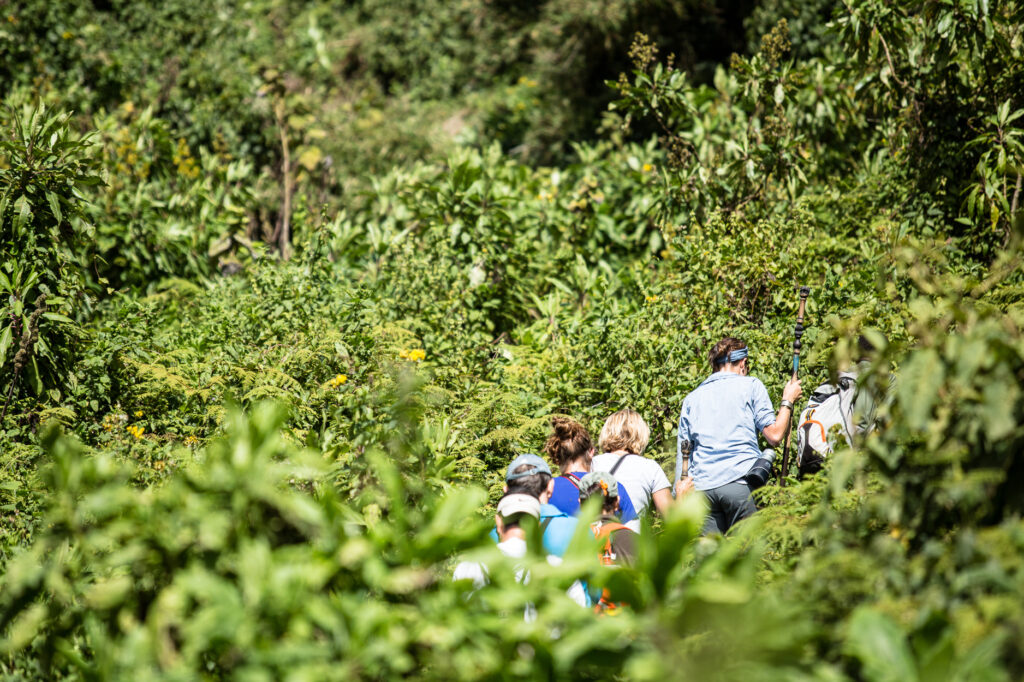
What is Chimpanzee trekking?
Chimpanzee trekking involves hiking into chimp habitat in Uganda, Tanzania, Rwanda and less commonly, the Democratic Republic of the Congo, with a local expert tracker and an armed ranger. Once a community is located, visitors are allotted one hour to watch the habituated chimps. Typically, group sizes are limited to six persons 16 and older, with twice-daily departures—in the morning and the afternoon. The excursion usually takes two to six hours (inclusive of a pre-trip orientation) and onlookers are asked to remain seven meters (23 feet) away. Travelers wanting longer, more immersive chimp encounters might consider a day-long chimpanzee habituation experience, described in greater detail below.
Where to go Chimp Trekking
Wild chimpanzees are found almost exclusively in the dense forests of Central and West Africa. Contrary to the wildlife you’ll encounter on plains safaris and even gorillas, the animated lives of chimpanzees unfold amid the forest canopy. While not elusive, per se, it does mean the animals will make themselves visible on their terms—you may find some immediately; you may need to hike for a short while.
It’s widely acknowledged that the best chimpanzee trekking takes place in Kibale National Park, Uganda, where approximately 1,500 chimpanzees live in an area the size of New York City. The population is divided into at least a dozen communities, four of which are habituated—that are completely unphased by the human onlookers who have visited most days since 1993. In addition to chimps, Kibale visitors will encounter an abundance of diversity: some 120 mammals (including baboons, red-tailed monkeys, black and white colobus, antelope and elephants) and 370 species of birds.
The most popular trek in the park is the Kanyanchu Primate Walk which lasts about three hours, is limited to six persons 16 and older, and departs at 8 a.m., 11 a.m. and 2:00 p.m. The odds of encountering chimpanzees is higher than 90 per cent.[1]

Chimp Trekking in Uganda
Uganda is home to an estimated 5,000 chimpanzees, making it one of Africa’s top destinations for trekking and habituation experiences. What’s more, travelers wanting to gorilla trek, too, can get both primate tracking experiences on one trip.
Besides Kibale, described above, chimpanzee trekking can be done in the Budongo Forest within Murchison Falls National Park where 16 permits are issued each day for two small groups of eight persons over age 15.[2]
Alternatively, an isolated family of habituated chimpanzees live in Kyambura Gorge, a steep-sloped, tree-carpeted ravine that dramatically severs the plains of Queen Elizabeth National Park.[3]
Chimp Trekking in Tanzania
In Tanzania, there are only two chimpanzee-protected areas where trekking is possible. Follow in the footsteps of Jane Goodall—the chimpanzees dearest ally and fiercest advocate—in Gombe National Park. In this, boat-accessed, pocket-size park (just 13 square miles), a fragile strip of chimpanzee habitat skirts the steep slopes and river valleys that hem the sandy northern shore of Lake Tanganyika. Home to approximately 95 chimps, visits are limited to six-person groups age 15 and older and are capped at one hour.
South of Gombe, but still on Lake Tanganyika, chimpanzee trekking can be done at boat-access-only and road-free Mahale Mountains National Park. Chimp trekking is offered by just two lodgings (EJ only recommends Greystoke Mahale, a barefoot luxury beachfront lodge comprised of six thatched bandas and boasting excellent guides) and thanks to steep inclines and dense jungle, is counted among the most strenuous trekking on this list. Though Mahale Mountains National Park boasts some 800 primates, about 60 individuals from Mimikere or “M” group are habituated.
Chimp trekking in Rwanda
Like Uganda, Rwanda is another destination where travelers can nab both primate experiences: gorilla tracking in Volcanoes National Park (northern Rwanda) and chimpanzee trekking in Nyungwe Forest National Park (southern Rwanda).
Nyungwe, a high altitude and mountainous reserve, is home to ~500 chimpanzees who raucously ply the tightly woven closed canopy. Of the entire population, two troops are habituated. Trekking groups are limited to eight persons age 15 years and older, and are led by a guide and an armed ranger, in addition to (optional) porters. On the day of a trek, you’ll typically depart on foot at sunrise with one human group permitted to visit one chimp troop. Observers are given an hour to enjoy the chimps’ company while remaining at least seven meters away. While not a technical hike, it’s important to be reminded of the altitude (as high as 9,600 feet above sea level), which may require some travelers to acclimatise.
Complementing chimp trekking in Nyungwe Forest, is a sumptuous guest stay at Nyungwe Forest Lodge. Here, a collection of 22 suites housed in five luxurious villas situates guests among the canopy where you’ll fall asleep to the cacophony of great blue turaco birds and rise to the melodies of mangabey monkeys.

Chimp trekking in the Democratic Republic of the Congo
Virunga National Park, located on the eastern edge of the Democratic Republic of the Congo, is the African continent’s first national park—established in 1925—and a UNESCO World Heritage Site. This biodiverse rainforest spans an area a little larger than the size of Delaware and is a sanctuary for gorillas, forest and savannah elephants, hippos, lions and chimpanzees. Chimpanzee habituation started in 1987 but decades of civil unrest closed Virunga to tourism until 2014 when the park officially reopened. Habituation efforts supported by the Frankfurt Zoological Society endure. Chimpanzee treks to the communities approximately 32 habituated members are limited to just four persons, departing each morning at 6:00 a.m.
Commonly accessed via Rwanda, travelers’ appetite for chimp trekking in Virunga largely depends on their willingness to travel to the DRC; even the national park’s official website admits it is “constantly threatened by war, poaching and illegal activities.” That said, intrepid travelers and safari veterans hop the border every year to visit this jewel of a park. Based on our own personal experiences in Virunga, Extraordinary Journeys travel experts can help you navigate the evolving security landscape and logistics. We highly recommend Mikeno Lodge, a collection of handsome thatched cottages that offer sweeping forest and volcano views—and conveniently, the location where chimpanzee treks depart from.
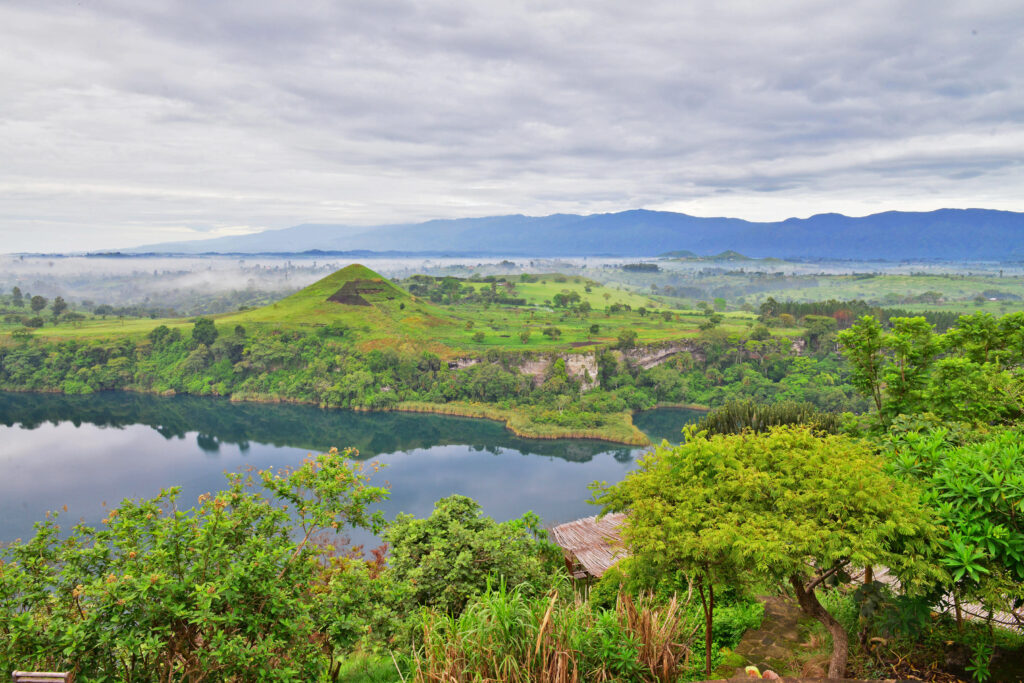
Interesting chimpanzee facts
Chimpanzees are among our closest relatives, sharing more than 98 per cent of our DNA. They typically live in family groups ranging from 15 to 20 members (though some may be much larger—up to 100), and each community has a unique personality of its own. Group life is crucial because chimpanzees are highly sociable, intelligent and communicative animals; their complex relationships and hierarchies (usually led by a dominant male) provide the mental and emotional stimulus they need. Chimps communicate largely through body language and hoots, pants and barks, and are one of the only species to create and use tools. Prying insects out of tight spaces or cracking hard nuts or fruits with rocks are creative activities chimpanzees are commonly known to engage in. Because most wild chimps live to 40 years or so, they have plenty of time to pass special skills on to younger generations. Chimp diets are varied, ranging from fruits and other plants to insects, eggs, meat and even carrion. Most male chimps stand just under four feet tall and weigh between 90 and 130 lbs. Females tend to be a little smaller, usually weighing between 60 and100 lbs.
The best time of year to go chimp trekking
Chimpanzee habitats largely straddle the equator and operate year-round, so when we speak about the best time to go trekking, the conversation should centre on wet and dry seasons rather than temperature.
During the dry season, chimpanzee communities are more mobile, traveling deeper into the jungle in pursuit of sustenance. This means that while trails will be less mud-caked and hiking will be comfortably less humid, you may have to trek further to locate them. Dry season also tends to align with peak tourist season when the demand for permits increases. Dry season along equatorial African countries generally runs from June to October.
“The best time to go chimpanzee trekking to avoid crowds is April through May, during the rainy season,” says Extraordinary Journeys Safari Specialist Jenny Salentine. “But you’ll be trekking in a rainforest so you’re likely to get wet any time of year.”
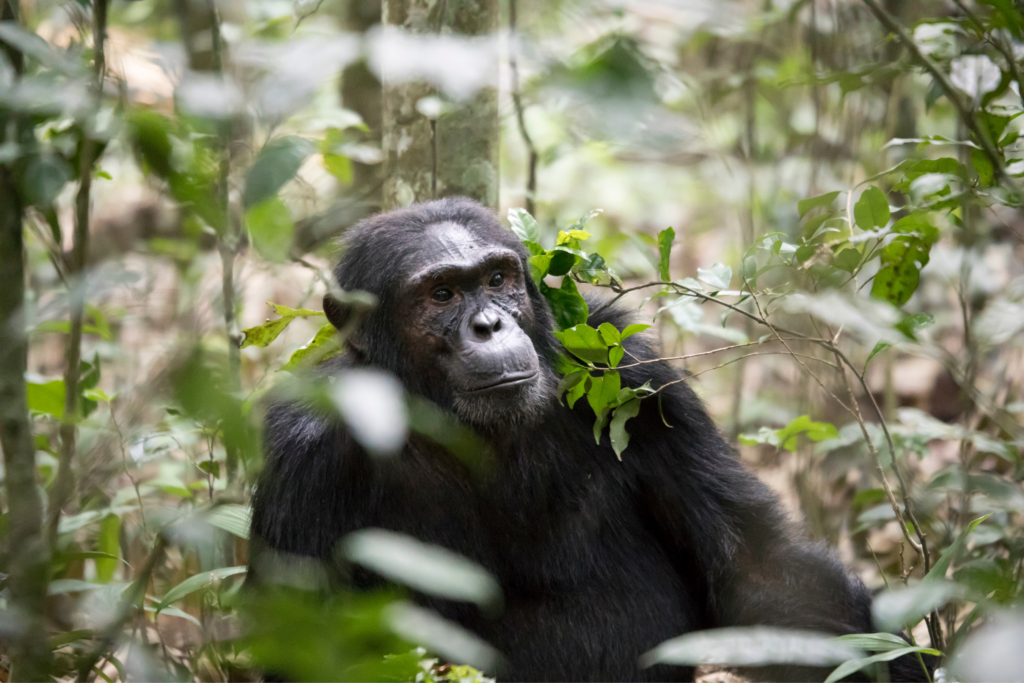
What should you bring on a chimp trekking safari?
- A small day pack (backpack)
- Snacks
- Water
- A camera (with the ability to turn off the flash)
- Durable, lightweight water-resistant hiking boots with grippy soles. (You’ll want good traction in case of muddy slopes.)
- A water-repelling but ventilated jacket
- Layered clothing (not only for varied weather conditions but to cool yourself if hiking uphill)
- Long sleeves and long pants are recommended thanks to prickly foliage you may trek through.
- Insect repellant
- Optional: Bring gaiters if you have them or tuck your pants into your boots to hinder the safari ants
- Optional: Wearing gardening gloves helps to avoid stinging nettles
Tips to prepare for chimpanzee trekking
- Permits must be booked in advance—a task that Extraordinary Journeys travel experts always take care of.
- To prevent transmitting human-borne diseases to the chimps, anyone who is ill or demonstrating signs of illness is not allowed into the park.
- There are minimum age requirements to go chimpanzee trekking. It varies by park but generally, youth must be 15 and older, in some cases 16. Many lodges have kid-friendly programming or childminding so parents with littles can enjoy a half-day trek.
- Depending on the reserve or park’s policy, you will be expected to maintain at least seven meters (23 feet) distance from the animals.
- To avoid negative attention, do not eat or snack near the chimpanzees
- Listen to your guide at all times.
- Trekking is limited to small groups. Depending on the park or reserve, some are limited to as few as four, most run at six, and others max out at eight.
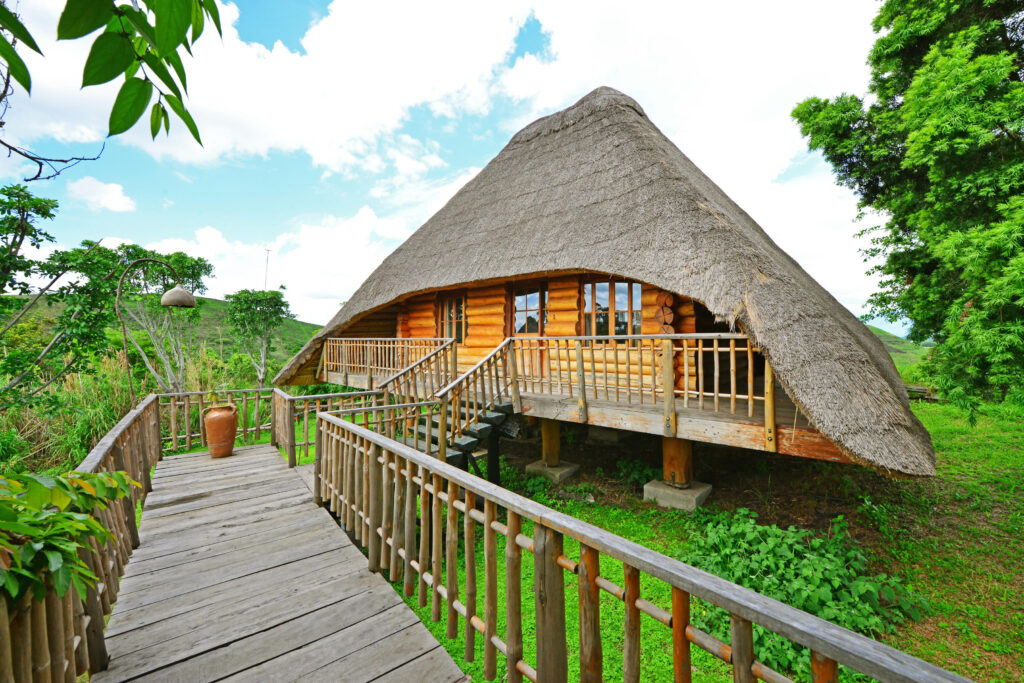
Chimpanzee trekking versus gorilla trekking
Species aside, the greatest comparison between chimp and gorilla trekking distills to the fact that chimpanzees spend more time in the trees.
While gorillas eat and move through the forest floor, chimps spend a lot of their day moving through the canopy. Watching them swing branch-to-branch or build nests is fascinating but admittedly, makes them trickier to spot, harder to snap good pictures of, and all that looking up can make your neck sore.
Jenny—who has trekked with both gorillas and chimpanzees—admits, “Sometimes you just have to enjoy watching them and accept that your pictures won’t be amazing. That said, we got a few good ones!”
Jenny also shared that chimps were livelier and noisier than gorillas. “You feel like you are in among the group, surrounded by them and it makes the whole experience really exciting in a way that was quite different from my gorilla trekking experience. [What’s more], the chimp trek was much flatter than the gorilla trek, but the forest was quite dense. Because the trek wasn’t as strenuous, I felt like I had more time to appreciate the forest, to take in the birds and other monkeys that were around.”
Another major difference between the two experiences is duration. Gorilla treks skew much longer, lasting as long as eight hours in some cases. Both experiences allow visitors to spend one hour in the audience of the animals but typically, accessing socialised chimp troops is easier than lengthy treks to gorillas—think: 30 minutes to three hours. As such, chimpanzee trekking is typically offered twice daily: a morning and an afternoon departure. Opinions on the best time of day varies. “Some people say it’s better to go in the morning because the chimps are sleepy in the afternoon; other people say it doesn’t matter,” says Jenny. “We went in the morning and they were definitely active.”
Like gorilla tracking, chimpanzee tracking requires a permit and the total number of permits issued each day is tightly regulated.
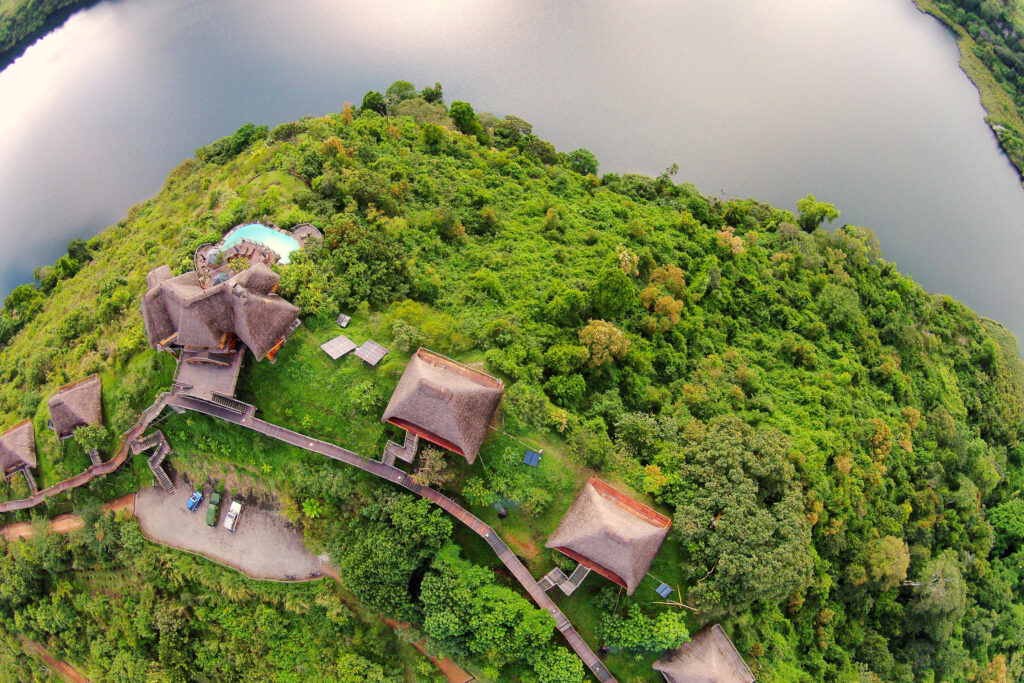
Chimpanzee trekking versus a chimpanzee habituation experience
In addition to chimpanzee trekking, some parks (like Kibale in Uganda) and reserves offer chimpanzee habituation experiences.
During a chimpanzee trek, hikers visit communities that are habituated to human presence. Habituation is a process that can take two years. Alongside experts, you’ll contribute to research and the habituation process.
The upside of participating in a habituation experience is that you can spend an entire day with a community, rather than just the permitted hour. This extended time allows you to identify the different characters and their habits while better grasping group dynamics and hierarchy.
A chimpanzee habituation experience also offers a real chance to develop fieldwork skills and learn about behavioural research. In Kibale National Park, guests are accompanied by both UWA rangers and guides who know the chimps intimately and can speak to the history of the group and changes over time. Overall, the chimpanzee habituation experience is more immersive than trekking thanks to the sheer number of hours spent with the chimps.
Chimp trekking FAQs
Is chimpanzee trekking safe?
It’s true that when we speak about chimpanzee trekking, we are talking about wild primates but what’s important to remember, is that small groups visit with communities who have been habituated, a process that involves years of human presence. Alternatively, unhabituated chimps fear humans; they simply flee upon encountering us. Habituated communities will be familiar with the park personnel who visit twice daily, so parades of human observers are not totally alien to the animals.
Listening to your guide and respecting chimp etiquette is key to safety. Maintain a distance and never eat, snack or smoke while in the company of chimpanzees. Flash photography is prohibited, speak quietly and move about calmly. Should a situation necessitate it, all treks are accompanied by an armed ranger who can fire a loud warning shot.
Ultimately, chimpanzee trekking is very safe. Hikers might instead redirect their concern toward moving safely through the jungle to avoid stinging nettle or slippery footing along muddy trails.
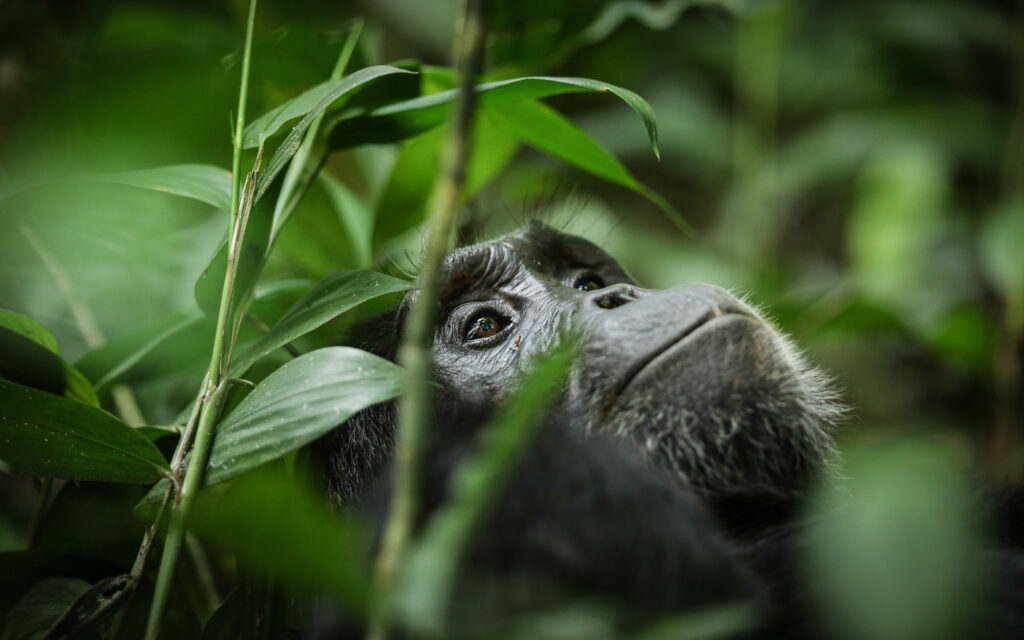
Are chimps friendly to humans?
Perhaps we can thank the prevalence of chimpanzees on tv and in films, and celebrity chimp owners for normalising the idea that these primates are friendly to humans. Admittedly, even Jane Goodall was video recorded having tender and friendly moments with her research subjects.
In the context of chimp trekking, we must remember these are wild animals, despite having been habituated. Given their intellectual capacity and memory, you may witness chimpanzees exhibiting familiarity with some of the guides and rangers they are acquainted with, but ideally, they will be indifferent to your audience, carrying on with their lives in the quiet company of human observers.
Check out these itineraries:
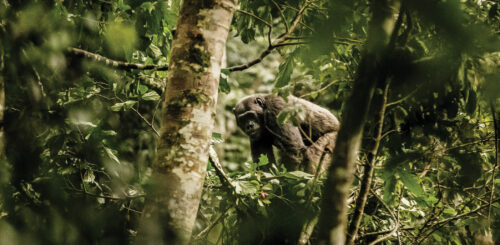
- Itinerary
Primates and Lakes: Gorillas, Monkeys, and Adventure in Rwanda
Unforgettable primate encounters, culture and luxurious lodging
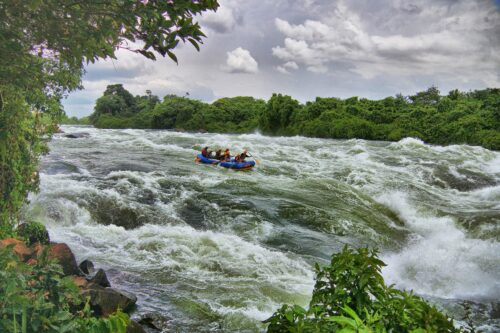
- Itinerary
Uganda: Great Apes and Adventure
Primates and White-Water Rafting on the Nile
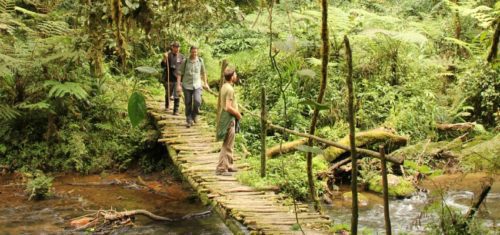
- Itinerary
Extraordinary Encounters in Uganda
Nile Cruises, Gorilla and Chimpanzee Trekking
[1] https://ugandawildlife.org/national-parks/kibale-national-park/
[2] https://www.murchisonfallsparkuganda.com/information/chimpanzee-tracking-in-budongo-forest/
[3] https://www.queenelizabethparkuganda.com/information/chimpanzee-tracking/